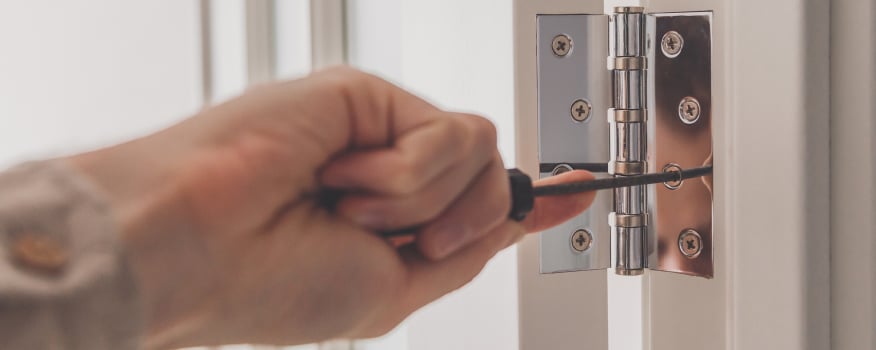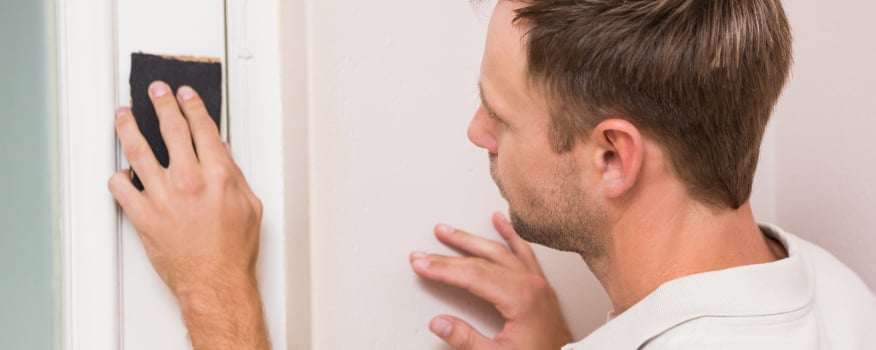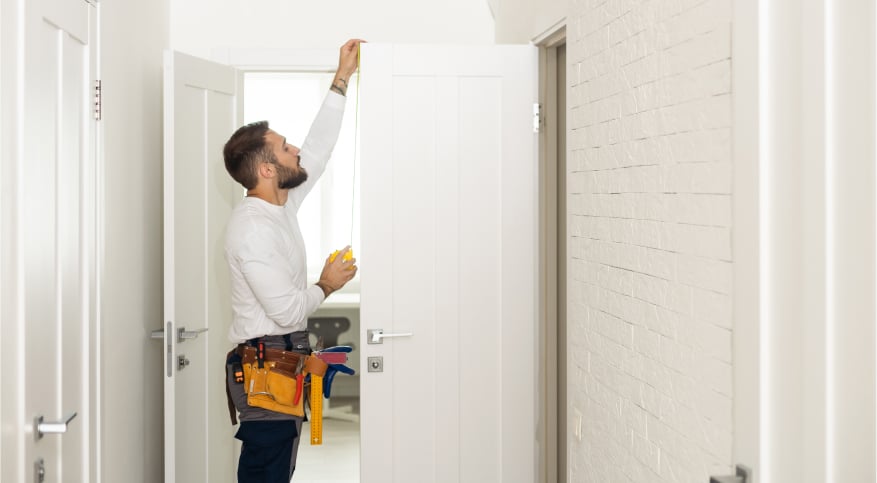When a door won’t close, it’s highly possible that with time, the door has drooped until the latch stopped lining up with the hole in the strike plate on the door frame. Good news: in most cases, it’s easy to fix a sticking door. Read on for a simple, step-by-step troubleshooting guide that’ll help you figure out why your door won’t close and show you how to fix a door that won’t close properly.
Tools and Materials
- Cordless drill w/ drill bits or screwdriver
- Five-in-one tool or wood chisel
- Hammer
- Scrap piece of wood
- Sander
- Metal file or sandpaper
- Wood chisel
- Lipstick
- Wood filler
1. To fix a sticking door, troubleshoot it with lipstick
If your door won’t close, you need to find out what’s out of line. To see whether the latch on the door is missing above or below the hole on the strike plate, grab a lipstick or a marker and rub it on the door latch. Then, put a strip of masking or painter’s tape over the strike plate and close the door. When you open the door, you should see a mark where the latch hit the strike plate hole. If the mark is below the hole, you most likely have sagging hinges; above means the strike plate is out of position.
2. Door still won’t close? Check your hinges

Gravity has a way of pulling everything down. And if your door has been hanging around for a while, chances are its weight has pulled the hinges down just far enough to throw the latch out of alignment with the strike plate hole. To fix a sagging door, tighten all three screws in each of the three hinges with a screwdriver or drill.
If you find that the door won’t close after that, try swapping out the middle screw of the top hinge with a longer, three-inch screw. That’ll penetrate the wall framing and pull in the entire door frame slightly, lifting the door into position. If you need to pull the door down slightly, use that procedure on the bottom hinge.
3. Try shimming or sanding

Still not shutting right? It could be sunken hinges. Take the hinges off the door frame. Make a shim by cutting a small piece of cardboard or other material to fit into the hinge mortise (the shallow cut in the door where the hinge sits) to add a cushion to support the hinge and balance the door. Then replace the hinges and check the door.
On the other hand, the hinge mortises may be too shallow. So if shimming doesn’t fix it, sand down the mortises till they’re flush with the door frame.
4. Look at the strike plate hole
Still no luck? Don’t give up yet. Check to see if the latch is hitting the strike plate above or below the hole—and how far off it is. If it’s off more than an eighth of an inch, you may have to shift the strike plate hole. But if it’s less, try to enlarge the hole. Use a half-round metal file so it matches the curved shape of the hole.
5. Try moving the strike plate to fix a door that won’t close
If the latch hits the strike plate at the right level but doesn’t go in far enough, or if it’s more than an eighth-inch too high or low, you need to reposition the strike plate—either up or down, in or out. Remove the plate and use a sharp chisel to enlarge the mortise. Then, drill new sixteenth-inch holes for the screws, install the plate and fill the gap in the mortise with wood filler.
What to do if none of our suggestions for how to fix a sagging door are working

Plane it
If you’ve gone through every step for how to fix a door that won’t close properly without success, consider planing the door. Mark the area where your door is sagging, then shave it down till it closes properly. Then, sand and paint or varnish the exposed wood grain. Keep in mind that you can only plane a door that’s solid wood. Hollow-core doors contain mostly honeycomb cardboard inside, so planing can do more harm than good.
Replace it
If your door is drooping so badly that none of our solutions for how to fix a door that won’t close or latch solves the problem, it’s time to think about replacing the door altogether. One option is to buy a slab door that’s slightly bigger than the existing frame, with no pre-cuts for hinges and hardware, and then trim it to fit. It’s relatively inexpensive, but it’ll cost you some time and test your carpentry skills.
A pre-hung door is a more expensive but simpler way to go. It comes already set into the frame, along with hinges, locks and handles.
The best way to fix a door that won’t close is to keep it working properly in the first place
With some routine maintenance, you can prevent your doors from sagging in the first place. Make a habit of checking the door, hinges and frame for any signs of wear, damage or misalignment, tightening any loose screws and hardware, and your doors will last longer and work better.
An open and shut case for becoming a Frontdoor® member
A door that won’t latch or close is one of those minor annoyances that can be taken care of with a little work and the right advice. At Frontdoor, we‘re here to help you keep small issues from turning into bigger—and more expensive—ones.
Want to learn more about how to fix a sagging door, or anything else about keeping things working properly around your home? Download the Frontdoor® app if you haven’t already, for a wide range of helpful DIY tips or to chat with a helpful, friendly Frontdoor Expert.
Was this article helpful?





